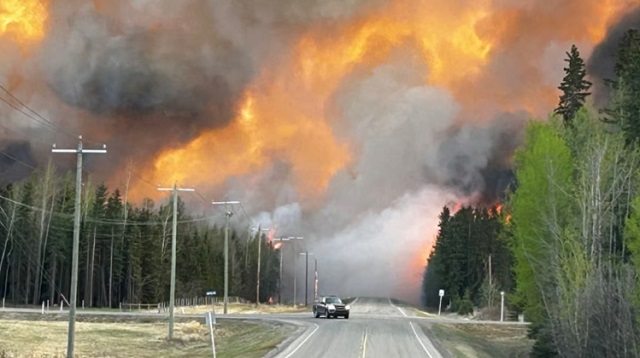Alberta
Thank the beetle and deadwood ‘fuel’ that should have been cleared

By Josh Andrus
Originally posted in the Western Standard
Parks Canada officials admit they failed to conduct controlled burns of dead pine trees, which now pose a significant fire risk.
While Ottawa fixates on climate change rhetoric, their neglect of forest fire prevention has left Alberta’s landscapes vulnerable to devastation.
Last week, a shining beacon of the beauty of our province was partially destroyed as a wildfire burned through the picturesque town of Jasper. Our thoughts and prayers go out to the victims.
Thankfully there has been no reported loss of life. But many people’s livelihoods have been wiped out. The question is how did this happen, and what could have been done to prevent it?
Smokey Bear’s famous saying was: “Only you can prevent forest fires.” And, in this case, proactive measures certainly could have made a difference.
Unfortunately, the entire federal government seems to have forgotten Smokey’s key point. Fire prevention on national park land is federal jurisdiction.
In 2022, Environment Minister Steven Guilbeault was informed that Parks Canada managers had not taken adequate precautions to protect the Town of Jasper from wildfires, according to documents obtained by Blacklock’s Reporter. At that time, Parks Canada officials admitted they had failed to conduct controlled burns of dead pine trees, which posed a significant fire risk.
“A mountain pine beetle infestation has brought significant changes to forests in Alberta, including Jasper National Park, with consequences for wildfire risk,” Guilbeault was informed.
Almost half of Jasper’s Whitebark Pine forest, 44%, was infected by beetles. However, few steps were taken to reduce the risk to the Town of Jasper with controlled burns of the surrounding forest, records show.
“Fire has not yet been applied for Whitebark Pine restoration,” stated a 2022 implementation report. “Mechanical thinning has been completed in 1.6 hectares, which is a small area relative to the amount of Whitebark Pine habitat.”
No reason was given for failing to take precautions. Since the fire, Guilbeault has made no public mention of the management reports.
Even though federal officials, including his department, knew the raging pine beetle was a serious hazard, Guilbeault blamed climate change: “As we are seeing in Canada and all around the world, we are seeing more and more aggressive forest fires,” he said on a media call on Monday.
Landon Shepherd, Incident Commander for Parks Canada, also attributed the intensity of the blazes to climate change: “This isn’t meant to be a discussion about climate change, but anyone who’s involved in fire management can tell you that things have become more difficult, especially in the last five years, to manage impacts.”
The 2022 warnings were not the first time concerns about a lack of fire prevention in national parks have been raised.
In 2018, CBC reported concerns from experts. Emile Begin and Ken Hodges, foresters for 40 years who had been studying Jasper National Park, found multiple issues with the forest that make it susceptible to a fire.
“You have fire suppression that has occurred for many years — therefore, you get a lot of dead fuel that would have been consumed by a natural process,” Hodges said. “The mountain pine beetle adds even more fuel to the situation.”
“You’ve got a major catastrophe on your hands if you get a match thrown into that.”
When pressed about the concerns, Alan Fehr, a superintendent for Jasper National Park, said: “We’re quite comfortable with where we are with our own emergency planning and evacuation planning.”
Hodges disagreed: “The potential that’s out there is actually scary. Hopefully, we’re wrong.”
Despite the repeated warnings of potential devastation due to forest management practices, Ottawa continues to point to climate change as the cause of the fires.
The Alberta government has been preparing, and increased its firefighting budget by more than 50% to $155.4 million this year. Alberta’s firefighting budget is now the highest it has ever been (despite misinformation about cuts.)
However, without proper fire prevention on national park land, blazes can become out of control quickly — as the warnings indicated.
Smokey Bear would be horrified. Clearly, Ottawa needs to spend less time interfering in provincial jurisdiction and more time focusing on things that actually are federal jurisdiction, like fire prevention in national parks.
Their inability to see the forest through the trees and take legitimate action to protect our national parks from the fury of an out-of-control wildfire demonstrates a degree of ineptitude that is, quite frankly, shocking.
Ottawa needs to stay in its lane and focus on its own jurisdiction, and they need to stop blaming climate change for their own ineptitude.
Alberta
Alberta school boards required to meet new standards for school library materials with regard to sexual content

Alberta’s government has introduced new standards to ensure school library materials are age-appropriate.
School libraries should be safe and supportive places where students can learn and explore without being exposed to inappropriate sexual content. However, in the absence of a consistent standard for selecting age-appropriate library materials, school boards have taken different approaches, leading to concerns about safeguards in place.
In response to these concerns, and informed by feedback from education partners and the public, Alberta’s government has created standards to provide school boards with clear direction on the selection, availability and access to school library materials, such as books.
“Our actions to ensure that materials in school libraries don’t expose children to sexual content were never about banning books. These new standards are to ensure that school boards have clear guidance to ensure age-appropriate access to school library materials, while reflecting the values and priorities of Albertans.”
The new standards set clear expectations for school library materials with regard to sexual content and require school boards to implement policies to support these standards.
Standards for school library materials
Under the new standards, school libraries are not permitted to include library materials containing explicit sexual content. Non-explicit sexual content may be accessible to students in Grade 10 and above, provided it is age-appropriate.
“Protecting kids from explicit content is common sense. LGBTQ youth, like all children, deserve to see themselves in stories that are age-appropriate, supportive and affirming – not in material that sexualizes or confuses them.”
School boards must also regularly review their school library collections, publish a full list of available materials and ensure that a staff member supervises students’ access to school library materials. School boards will have to remove any materials with explicit sexual content from their school libraries by October 1.
School board policies and procedures
All school boards must have publicly available policies that align with the new standards for selecting and managing library materials by January 1, 2026. School boards can either create new policies or update existing ones to meet these requirements.
These policies must outline how school library materials are selected and reviewed, how staff supervise students’ access throughout the school day, and how a student, parent, school board employee or other member of the school community can request a review or removal of materials in the school library. School boards are also required to clearly communicate these policies to employees, students and parents before January 2026.
“A robust, grade- and age-appropriate library catalogue is vital for student success. We welcome the ministry’s initiative to establish consistent standards and appreciate the ongoing consultation to help craft a plan that will serve our families and communities well.”
“Red Deer Public Schools welcomes the new provincial standards for school library materials. Our division is committed to maintaining welcoming, respectful learning spaces where students can grow and thrive. Under the new standards for school libraries, we remain dedicated to providing learning resources that reflect our values and support student success.”
Quick facts
- The new standards will apply to public, separate, francophone, charter and independent schools.
- The ministerial order does not apply to municipal libraries located within schools or materials selected for use by teachers as learning and teaching resources.
- From May 26 to June 6, almost 80,000 people completed an online survey to provide feedback on the creation of consistent standards to ensure the age-appropriateness of materials available to students in school libraries.
Related information
- Ministerial Order
- School library standards engagement
- Reference Materials: Content warning: this document contains graphic content that may be disturbing to viewers and is not appropriate for young viewers. Viewer discretion is advised.
Alberta
Fourteen regional advisory councils will shape health care planning and delivery in Alberta

Regional health councils give Albertans a voice
Albertans want a health care system that reflects where they live and adapts to the unique needs of their communities. As part of the province’s health care refocus, Alberta’s government committed to strengthening community voices by providing more opportunities for Albertans to bring forward their local priorities and offer input on how to improve the system.
The regional advisory councils, made up of 150 members from 71 communities, will advise Alberta’s four health ministries and the newly refocused health agencies: Primary Care Alberta, Acute Care Alberta, Assisted Living Alberta and Recovery Alberta. Each council will explore solutions to local challenges and identify opportunities for the health system to better support community decision-making.
“By hearing first-hand community feedback directly, we can build a system that is more responsive, more inclusive and ultimately more effective for everyone. I am looking forward to hearing the councils’ insights, perspectives and solutions to improve health care in all corners of our province.”
“Regional advisory councils will strengthen acute care by giving communities a direct voice. Their insights will help us address local needs, improve patient outcomes and ensure timely access to hospital services.”
“A ‘one-size-fits-all’ approach does not address unique regional needs when it comes to mental health and addiction challenges. These councils will help us hear directly from communities, allowing us to tailor supports and services to meet the needs of Albertans where they are.”
“Every community has unique needs, especially when it comes to seniors and vulnerable populations. These regional advisory councils will help us better understand those needs and ensure that assisted living services are shaped by the people who rely on them.”
Members include Albertans from all walks of life, health care workers, community leaders, Indigenous and municipal representatives, and others with a strong tie to their region. About one-third of members work in health care, and more than half of the council chairs are health professionals. Almost one-quarter are elected municipal officials, including 10 serving as chairs or vice-chairs. Ten councils also include a representative from a local health foundation.
Council members will share local and regional perspectives on health care services, planning and priorities to help ensure decisions reflect the realities of their communities. By engaging with residents, providers and organizations, they will gather feedback, identify challenges and bring forward ideas that may not otherwise reach government.
Through collaboration and community-informed solutions, members will help make the health system more responsive, accessible and better able to meet the needs of Albertans across the province.
“As Primary Care Alberta works to improve access to primary health care services and programs across Alberta, we are grateful to have the opportunity to tap into a dedicated group of community leaders and representatives. These people know their communities and local needs, and we look forward to learning from their experiences and knowledge as we shape the future of primary care in Alberta.”
“The regional advisory councils will help to bring forward the voices of patients, families and front-line providers from every corner of Alberta. Their insights will help us plan smarter and deliver care that’s timely, effective and truly local. We look forward to working closely with them to strengthen hospital and surgical services across the province.”
“Nobody understands the health care challenges unique to a community better than the people who live there. The regional health advisory councils are made up of those living and working on the front lines across the province, ensuring we are getting the perspective of Albertans most affected by our health care system.”
“Alongside Recovery Alberta’s staff and physician team, these regional advisory councils will build upon the high standard of mental health, addiction and correctional health services delivered in Alberta.”
Indigenous Advisory Council
Alberta’s government continues to work directly with Indigenous leaders across the province to establish the Indigenous Advisory Council to strengthen health care services for First Nation, Métis and Inuit communities.
With up to 22 members, including Indigenous health care workers, community leaders and individuals receiving health care services, the council will represent diverse perspectives across Alberta. Members will provide community perspectives about clinical service planning, capital projects, workforce development and cultural integration in health care.
Related information
-

 Also Interesting1 day ago
Also Interesting1 day ago9 Things You Should Know About PK/PD in Drug Research
-

 Business1 day ago
Business1 day agoCannabis Legalization Is Starting to Look Like a Really Dumb Idea
-

 Business2 days ago
Business2 days ago‘Experts’ Warned Free Markets Would Ruin Argentina — Looks Like They Were Dead Wrong
-

 Business2 days ago
Business2 days agoWEF-linked Linda Yaccarino to step down as CEO of X
-

 Business1 day ago
Business1 day agoCarney government should recognize that private sector drives Canada’s economy
-

 Bruce Dowbiggin1 day ago
Bruce Dowbiggin1 day agoThe Covid 19 Disaster: When Do We Get The Apologies?
-

 Media1 day ago
Media1 day agoCBC journalist quits, accuses outlet of anti-Conservative bias and censorship
-

 Automotive2 days ago
Automotive2 days agoAmerica’s EV Industry Must Now Compete On A Level Playing Field




